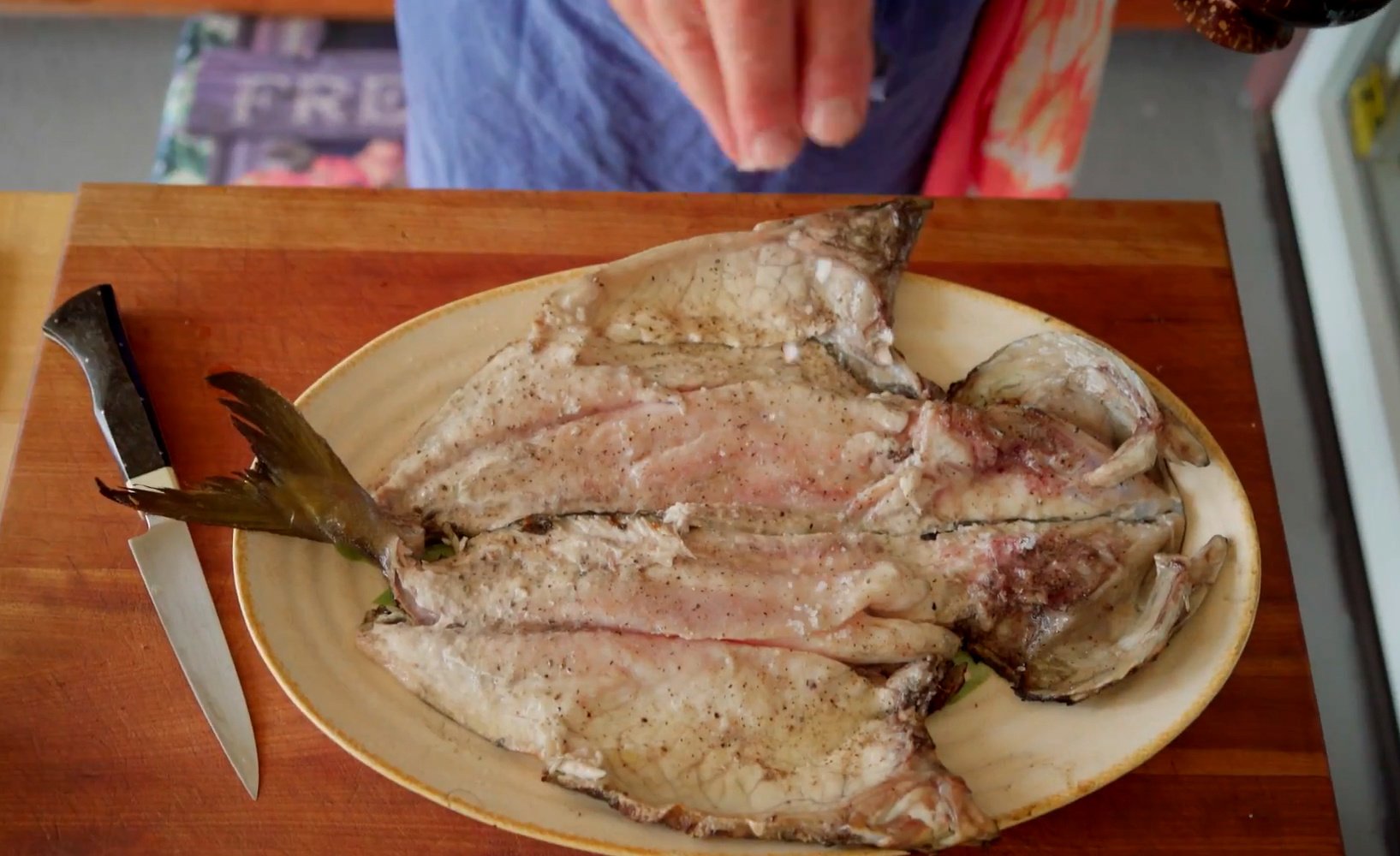TECHNIQUE: Butterflied Hawaiian Kanpachi
Watch Video Here or read the recipe below:
Watch Chef Paley Butterfly Hawaiian Kanpachi!
Recipe below:
This recipe relies on very few ingredients so we can honor this beautiful creature in its purest form. As this is not really a recipe, but more of a technique, feel free to substitute ingredients as you like. For example, sub parsley instead basil, if that’s what you have in your garden. If you don’t have course sea salt only kosher, that works too. No olive oil or lemon? You will need some kind of fat and some kind of acid. So have fun with it and make it your own.
To butterfly a fish is like to spatchcock a chicken. You would do it because it would cook more evenly and more quickly. But, if it’s intimidating, simply put it on the grill as is, bones and all. These will come out easily after the fish is done. Adjust your cooking time depending on how hot your grill gets.
If you are a city dweller and you have no grill? No problem, I got you. Just follow my oven method in this recipe.
You can serve this fish alongside warm tortillas, grilled pineapple salsa and guacamole. You can do something fancier by serving it with wild rice pilaf or stir-fry of vegetables. Most of all, enjoy this beautiful fish. It is delicious no matter which way you prepare and serve it.
--Chef Vitaly Paley
INGREDIENTS
- 1 3-to-4-pound scaled, gilled and gutted Hawaiian Kanpachi, butterflied.
- 2 tablespoons extra virgin olive oil, plus more for finishing
- 2 tablespoons coarse sea salt, plus more for finishing
- Juice of half a lemon, plus 4 to 5 lemon wedges to garnish the platter.
- Handful of hand torn fresh basil leaves
- Freshly ground black pepper
THE PROCESS (GRILLED)
Preheat the grill until it is hot. Temperatures and times may vary depending on if you use charcoal or gas. You will need it hot, so the skin of the fish does not stick and gets crispy and bubbly. Rub the fish all over with only two tablespoons of oil. Hawaiian Kanpachi is an oily fish, and you don’t want the grill to flare up because of excess oil on it.
Rub it all over with two tablespoons of oil. If you have a fish basket big enough to hold the fish whole, place it into the basket, close it and set it on the grill skin side down. If you don’t have a fish basket and prefer to live dangerously like me, place the fish directly on the grill, skin side down and cook until you see the edges get lightly brown and the flesh on top starts to become white around the edges, about 10 minutes.
If you are cooking in a basket flip the fish over. If cooking directly on the grill, use a big spatula or two and carefully flip the fish over onto its flesh side. At this point, the fish should be two thirds cooked. I prefer to cook Hawaiian Kanpachi to be slightly underdone and pink inside. This should take approximately 5 minutes longer. If you like yours more well done, simply double the cooking time. Hawaiian Kanpachi is very forgiving. Because of its fat content it is hard to overcook.
When done, carefully transfer your fish to a serving platter, skin side down or skin side up is up to you. If you choose to serve it skin side up, it will help keep the skin crispy longer. I prefer to turn mine over and serve it skin side down so I can see the contrast of white flesh, specks of black pepper and sprinkling of green herbs on top.
Either way, sprinkle it generously with more salt, grind fresh pepper all over, toss a few torn leaves of basil all around, drizzle with lots more olive oil, garnish with lemon wedges and enjoy.
THE PROCESS (OVEN)
Preheat the oven to 450F. Place an ovenproof pan large enough to hold the whole fish and preheat the pan for at least 15 minutes. It helps if you have either a cast iron or a nonstick one but use whatever pan you have.
Rub the exterior and interior of the fish with two tablespoons of olive oil all over then with two tablespoons of salt. Open the oven, using oven mitts carefully remove the pan then slide the fish onto it. Place the pan back into the oven and cook the fish for about 20 minutes. If you are able, test with a probe thermometer. You want Internal temperature of the fish to register 130 F to 140 F for medium. Cook it longer if you like it more well done. If you don’t have a thermometer, insert a bamboo skewer or a pairing knife into the thickest part of the flesh. When it goes in without resistance, the fish is done. Cook it longer if it takes effort to go in.
When done, carefully transfer your fish to a serving platter, skin side down or skin side up is your choice. If you decide to serve it skin side up, it will help keep the skin crispy longer. I prefer to turn mine over and serve it skin side down so I can see the contrast of white flesh, specks of black pepper and sprinkling of green herbs on top.
Either way, sprinkle it generously with more salt, grind fresh pepper all over, toss some torn leaves of basil, drizzle with lots more olive oil, garnish with lemon wedges and enjoy.
